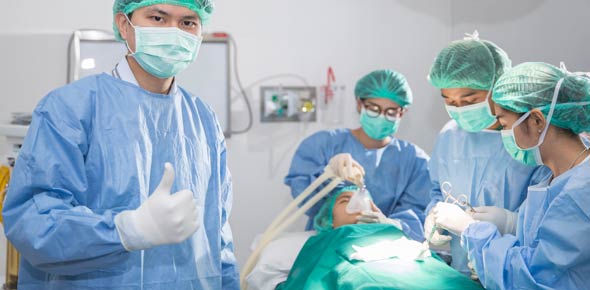720. Which type of suture would be used to invert the stump of an...
810. Bariatric surgery treats
766. Pathologic enlargement of the male breast is called
730. Which condition regarding sterile technique is NOT recommended?
731. Which of the following conditions is not an acceptable aseptic...
734. Which of the following is considered a break in technique?
753. Another name for the Kraske position is
820. The use of noninvasive high-energy shock waves to pulverize...
777. In which hernia is the blood supply of the trapped sac contents...
799. Thrombosed vessels of the rectum are known surgically as
813. Which item retracts the spermatic cord structure in...
728. Before handing a Penrose drain to the surgeon
743. Why are gowns, gloves, drapes, and instruments changed following...
759. Which of the following specimens is NOT placed in preservative...
784. An important consideration during cholangiogram is to
822. intra-abdominal pressure during the instillation of CO2 for...
740. Which of the following is NOT an acceptable technique when...
761. McBurney is an incision used for
790. Which organ is removed either because of trauma, a blood...
726. Intraabdominally, lap pads are most often used
737. when handing skin towels to the surgeon, where should the...
741. The procedure to follow if a hair is found on the operative field...
758. How is a frozen section sent to the lab?
769. A Whipple operation is surgically termed a
797. An entire tumor / mass removal is termed
739. Each of the following actions by a scrubperson prevents wounds...
745. The correct procedure for sterile dressing application is
763. During an appendectomy, a purse-string suture is placed around...
772. The curved transverse incision used for pelvic surgery is
809. Which structure(s) are identified and preserved in thyroid...
729. A closed-wound suction system works by
742. Cancer technique in surgery refers to
756. In an extreme patient emergency, a sponge count
757. Cultures obtained during surgery
791. Following a hemorrhoidectomy, a
800. A procedure done to give the colon a rest and then reversed is
821. Intraoperative cholangiograms can be performed either through...
719. In a gastrointestinal closure, the mucosa of the intestinal tract...
721. Why are bumpers or bolsters used on retention sutures?
780. An abdominal wall defect may be reconstructed using
795. The instrument most commonly used to grasp the mesoappendix...
801. A device that may obviate the need for an abdominoperineal...
733. When a sterile item is hanging or extending over the sterile...
746. When drop technique for an intestinal procedure is utilized
750. An enzyme extract from bovine blood used as a topical hemostatic...
755. Dark Blood in the operative field may indicate that the patient...
786. The intestinal layer in order, from inside to outside, is
744. A postoperative complication attributed to glove powder entering...
767. Sutures placed in a wound to prevent wound evisceration are...
773. Which breast procedure removes the entire breast and axillary...
814. After uterus removal in a hysterectomy
752. The desirable position for better visualization in the lower...
762. The simplest abdominal incision offering good exposure to any...
812. A gastroplasty
724. Which procedure would not require a pressure dressing?
727. A catheter commonly used in a gastrostomy is a
794. In a pilonidal cystectomy, the defect frequently is too large to...
803. Blunt dissection of the gallbladder from the sulcus of the liver...
817. White balancing a video camera in endoscopy requires the scrub...
735. In which situation should sterility be questioned?
782. In a cholecystectomy, which structures are ligated and divided?
748. The Sengstaken-Blakemore tube is used for
770. A left subcostal incision indicates surgery of the
732. The disposable circular staple designed to hold two tubular...
787. A common postoperative patient complaint following a laparoscopic...
723. A dissecting sponge that is a small roll of heavy cotton tape is...
802. An advanced inflammation of the bowel could be conservatively...
804. Direct visualization of the common bile duct is accomplished with...
807. In laparoscopy, tubal patency is checked by
754. All of the following are helpful in keeping accurate account of...
722. A Nissen Fundoplication procedure is done to correct
747. If the floor or wall becomes contaminated with organic debris...
765. A hernia occurring in Hesselback's triangle is called
793. Which gallbladder procedure ALWAYS requires intraoperative...
815. An irreducible hernia whose abdominal contents have become...
781. Mersilene is a(n)
816. Which type of endoscopy camera produces the truest color?
725. Peanuts and dissecting sponges are generally
783. All of the following statements refer to pilonidal cyst surgery...
818. Defogging the video camera is usually the responsibility of the
751. A common complication of extubation is
771. A lower oblique incision is a(n)
785. An instrument used to elevate the thyroid lobe during surgical...
808. In a thyroidectomy, a loop retractor retracts the
775. What incision is indicated for an esophagogastrectomy?
792. A benign anal wall "slit" type of lesion requiring excision is...
736. Transduodenal sphincterotomy refers to the incision made into the...
764. Gastrointestinal technique is required in all of the following...
796. Vaporization and coagulation of hemorrhoidal tissue can be...
768. Surgical enlargement of the passage between the prepylorus of the...
779. Which hernia leaves the abdominal cavity at the internal inguinal...
798. A surgical procedure performed to relieve esophageal obstruction...
749. A specially treated form of surgical gauze that has a hemostatic...
774. The breast procedure performed to remove extensive benign disease...
738. Irrigating fluid used to flush the organ between harvest and...
776. In which incision could retention sutures be used?
805. "Scratch" marking is done in surgery of the
806. Fogarty biliary catheters are used to
789. Portal pressure measurement is indicated in
811. Which incision would require cutting through Scarpa's fascia?
778. In which hernia does the herniation protrude into the inguinal...
788. A subphrenic abscess occurs in the
760. The term transduodenal sphincterotomy indicates surgery of the
819. A palliative invasive procedure done to prevent malnutrition or...
















